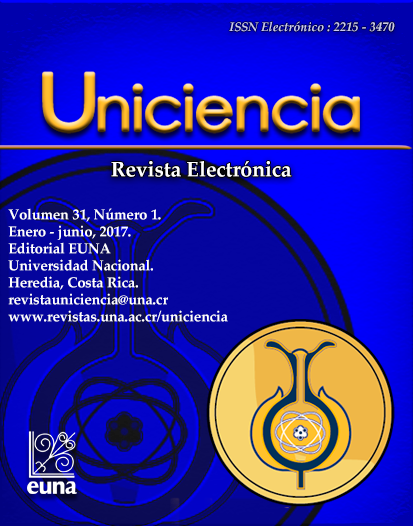Evaluation of Relative Abundance and Perception of the Presence of Rock Pigeons Columba Livia (Columbiformes: Columbidae) at the National University of Costa Rica
DOI:
https://doi.org/10.15359/ru.31-1.4Keywords:
Increase, perch, relative abundance, social perception, National University.Abstract
The presence of Columba livia dove in infrastructures leads to their deterioration. The increase of these birds in large cities has alarmed the population; the same situation occurs at the National University of Costa Rica premises. This study aimed to monitor the population due to its relative abundance. Five buildings within the university were selected, following the criterion of the presence of pigeons. Direct observation was conducted over a period of five months, three times a week. It was found that the west side of the Chemistry building is the most crowded (4.37 ± 1.17); the birds use spaces, such as air conditioners and holes on the roofs, as sites for nesting. 53% of the University workers interviewed disagreed in eradication processes. The availability of food resources and infrastructure are key factors to attract pigeons as these factors are ideal for nesting and roosting, which directly contributes to the growth of their populations. We recommend reducing artificial sites that can be used as perch, covering all the possible holes used for nesting, and educating people about potential problems that these pigeons can create.References
Ballarini, G., Baldaccini, N. E., y Pezza, F. (1989). Colombi in città: aspetti biologici, sanitari e giuridici: metodologie di controllo. Istituto nazionale di biologia della selvaggina: Alessandro Ghigi.
Barlow, N. D., Kean, J. M., & Briggs, C. J. (1997). Modelling the relative efficacy of culling and sterilisation for controlling populations. Wildlife Research, 24(2), 129-141. http://dx.doi.org/10.1071/WR95027
Giunchi, D., Soldatini, C., Vanni, L., Baldaccini, N. E., y Albores-Barajas, Y. V. (2012). Feral pigeons: problems, dynamics and control methods. INTECH Open Access Publisher. http://dx.doi.org/10.5772/31536
Haag-Wackernagel, D. (1995). Regulation of the street pigeon in Basel. Wildlife Society Bulletin, 23 (2), 256-260.
Haag-Wackernagel, D. y Moch, H. (2004). Health hazards posed by feral pigeons. Journal of Infection, 48(4), 307-313. http://dx.doi.org/10.1016/j.jinf.2003.11.001
Jerolmack, C. (2008). How pigeons became rats: The cultural-spatial logic of problem animals. Social Problems, 55(2), 72–94. http://dx.doi.org/10.1525/sp.2008.55.1.72
Johnston, R.F., y Janiga, M. (1985). Feral pigeons, Oxford University Press, New York.
Jokimaki, J., y Suhonen, J. (1998). Distribution and habitat selection of wintering birds in urban environments. Landsc. Urban Plann, 34, 253–263. http://dx.doi.org/10.1016/S0169-2046(97)00089-3
Lancaster, R. K., y Rees, W. E. (1979). Bird communities and the structure of urban habitats. Canadian Journal of Zoology, 57(12), 2358-2368. http://dx.doi.org/10.1139/z79-307
Mendez-Tovar, L. J.; Mainou, L. M.; Pizarro, S. A.; Fortoul-Vandergoes, T. y Lopez- Martinez, R. (1995). Fungal biodeterioration of colonial facades in Mexico City. Revista Mexicana de Micologia, 11, 133–144.
Olalla, A., Ruiz, G., Ruvalcaba, I., y Mendoza, R. (2009). Palomas, especies invasoras. Biodiversitas, 82, 7-10.
Pimentel, D., Lach, L., Zuniga, R., y Morrison, D. (2000). Environmental and economic costs of nonindigenous species in the United States. BioScience, 50(1), 53-65. http://dx.doi.org/10.1641/0006-3568(2000)050[0053:EAECON]2.3.CO;2
Ramírez, O., Amador, M., Camacho, L., Carranza, I. J., Chaves, E., Moya, A., y Quiros, W. (2008). Conocimiento popular de la paloma de Castilla (Columba livia) en el Parque Central de Alajuela. Zeledonia, 12(1), 14-19.
Sacchi, R., Gentilli, A., Razzetti, E., y Barbieri, F. (2002). Effects of building features on density and flock distribution of feral pigeons Columba livia var. domestica in an urban environment. Canadian Journal of Zoology, 80(1), 48-54. http://dx.doi.org/10.1139/z01-202
Downloads
Published
How to Cite
Issue
Section
License
Authors who publish with this journal agree to the following terms:
1. Authors guarantee the journal the right to be the first publication of the work as licensed under a Creative Commons Attribution License that allows others to share the work with an acknowledgment of the work's authorship and initial publication in this journal.
2. Authors can set separate additional agreements for non-exclusive distribution of the version of the work published in the journal (eg, place it in an institutional repository or publish it in a book), with an acknowledgment of its initial publication in this journal.
3. The authors have declared to hold all permissions to use the resources they provided in the paper (images, tables, among others) and assume full responsibility for damages to third parties.
4. The opinions expressed in the paper are the exclusive responsibility of the authors and do not necessarily represent the opinion of the editors or the Universidad Nacional.
Uniciencia Journal and all its productions are under Creative Commons Atribución-NoComercial-SinDerivadas 4.0 Unported.
There is neither fee for access nor Article Processing Charge (APC)






